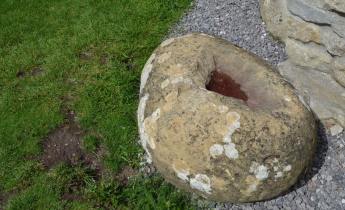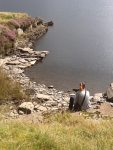Some months ago, I came across a brilliant comment online from a stranger in reference to the offhanded disparaging of practices of deep introspection as “navel gazing.” Her reply to the criticism of self-reflection as a self-absorbed waste of “navel gazing” time was simply:
“The humble navel…marking the spot where two become one and the story begins.”
When put that way, “navel gazing” sounded to me like a valuable addition to the practices of somatic spirituality. And so began my exploration of the phrase “navel gazing” and its potential applications within the realm of feminist somatic spirituality.

The phrase “navel gazing” possibly took on such negative connotations somewhere around the 14th century, during the Hesychast controversy of the Byzantine Empire, when factions of the Orthodox Church engaged in vigorous debate over the existence of a theological basis for somatic practice (among other disagreements). In rather simplified terms, one Church Father advocated for a somatic prayer practice that involved squatting, bending the head, fixing the gaze on the chest or navel, and bringing the attention to the heart. The other disparaged this practice of omphaloskepsis [omphalo = navel & skepsis = contemplation] as an utterly ridiculous, theologically unsupportable notion.
Given the historical period in which this debate took place, women as potential practitioners of omphaloskepsis and the potential spiritual value to them of this practice was obviously not addressed. In fact, just across the way in medieval Europe, a woman’s navel was even believed to have been the seat of her “wantoness,” according to the Cambridge bestiary.
So, fast-forward seven centuries and let’s talk about reframing navel-gazing– no longer a disparagement of self-absorption, but a feminist somatic spiritual practice for the modern age.
Being placental animals, our navels are actually scars. They mark the point at which we were all once linked to our mothers’ through what James Joyce called “the cords of all”. Whether our mothers are alive or dead, whether we were born in operating rooms or our mothers’ beds, whether our relationships with our mothers are precious, painful, or non-existent, we were all once bound to her, belly-to-belly, by our umbilical cords — an organ that connected ours shared physical structure, where the blood of past, present, & future flowed. “The humble navel,” as my unknown online muse remarked, is where the story of our motherline begins.

Our relationships with these umbilical scars we carry continue to evolve throughout our lifetimes. Our bodies grow and change from infants to young girls, from girls into women. We may use our motherline scars to attract sexual attention. We may adorn them, show them off in many ways. Or we may hide them because we feel the shame and pressure of an objectifying culture that says the seats of our motherline scars aren’t beautiful enough to flaunt; or an oppressive, controlling culture that passes moral judgement on our character if we let slip a glimpse of our bodies’ origins.
Some of us become mothers. Our navels are forever altered in appearance by pregnancy and birth, as we co-create the motherline scars of the next generation. Some of us gaze in wonder at our newborn’s navel at the same time that we weep with loathing at our postpartum one.
Perhaps it is time to reclaim the potential power of navel-gazing as a feminist spiritual practice; to return to where our story, our connection to the cords of all, began To our first scar that marks us as a growing, living, bleeding, mammalian creature of this world.
Bring your attention to your navel. Soften your gaze. Feel into this scar of your motherline.
Sit in wonder. And listen.
 Kate M. Brunner is a writer, healer, ritualist, & member of The Sisterhood of Avalon, studying at the Avalonian Thealogical Seminary. She is a brand-new resident of Heartwood Cohousing in Bayfield, Colorado & a homeschooling mother to her three children. She holds a BA from Tulane University, where she studied Economics, International Relations, & Religious Traditions. Kate is a presenter for Red Tents & women’s retreats. She also hosts seasonal women’s gatherings, facilitates labyrinth rituals, and leads workshops on an assortment of women’s spirituality topics. During 2016, she presented at the Association for the Study of Women and Mythology Conference in Boston, MA, at the SOA’s first open online conference, AvaCon 2016, & at the inaugural Ninefold Festival in Orange, CT.
Kate M. Brunner is a writer, healer, ritualist, & member of The Sisterhood of Avalon, studying at the Avalonian Thealogical Seminary. She is a brand-new resident of Heartwood Cohousing in Bayfield, Colorado & a homeschooling mother to her three children. She holds a BA from Tulane University, where she studied Economics, International Relations, & Religious Traditions. Kate is a presenter for Red Tents & women’s retreats. She also hosts seasonal women’s gatherings, facilitates labyrinth rituals, and leads workshops on an assortment of women’s spirituality topics. During 2016, she presented at the Association for the Study of Women and Mythology Conference in Boston, MA, at the SOA’s first open online conference, AvaCon 2016, & at the inaugural Ninefold Festival in Orange, CT.


Great post. I didn’t know the origin of the disparagement. I suppose if it was an ascetic practice, the point was to meditate on birth=death or perhaps birth=sex=death, with perhaps a reference to the sin of Eve. But we can transform that.
It is interesting that liberation theology feminists have been known to dismiss Goddess feminism as sheer navel gazing. Ah well….
Reclaiming the female body is personally healing, but it also an act with cultural-political significance! We only have to look as far as the huge opposition to abortion and even birth control to see why.
LikeLike
The tears…wow. I have been teaching my yoga classes with a focus on including the ‘womb heart’. brave, creative center recently. Today is the 17th anniversary of my Oma’s passing. We shared a room for the better part of 9 years. Her strength is felt deeply in my bones and I am encouraging my 19 year old daughter to rely on it as she struggles with homesickness off at college. Thank you.
LikeLike
Thanks, Kate. No matter the worries we carry with us, your belly-button thoughts will maybe give us a sense of humor, and so we are encouraged to take on this day with some kind of playfulness if possible. In terms of spirituality, the image of an “enso” or ink painted circle in Zen also comes to mind. Enjoyed your post. I love FAR.
LikeLike
I love this post, Kate! My navel is within my gaze as I type. Thank you!
LikeLike
Reading Sarah’s comment brought back a – I guess dialog/joke/? – from years ago. Q: Are you a member of the belly club? A: usually a puzzled “No”. R: Turn in your button!
Kate, you just gave a wealth of meaning to that “joke”! I sit here with my hand gentle and warm on my “button” and thoughts of my mother.
LikeLike
Amazing <3
LikeLike
Fascinating and thought provoking. The chakra in that area is also very related to this topic.
LikeLike
as soon as i read your words about the chakra, i recalled hearing this beautiful message in yoga one day— ‘belly backbends put pressure on the abdomen integrating divine will and personal will’
LikeLiked by 1 person
Love that
LikeLike
Thank you! I sometime flinch about so called introspection and hear the label ‘naval gazing’ running through my head. Then I remember when I first heard it said and who said it. And I reckon it was said in anger and frustration by someone who felt too frightened to see and own their own body’s sensations in that moment at least. Which reminds me of why I do trust and value whole body self-awareness – I believe it’s the essential tool for ending the cycle of family violence and learning to live vulnerably and honestly from the heart instead.
LikeLike
This is an enriching article. I am working on a series of somatic based poetry and was inspired to write one about the navel. When I came across this article, it was exactly what I needed to fill in the gaps and bring the poem to fruition. Thank you.
coriefeiner.com
LikeLike